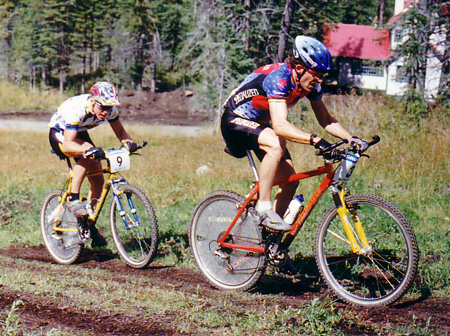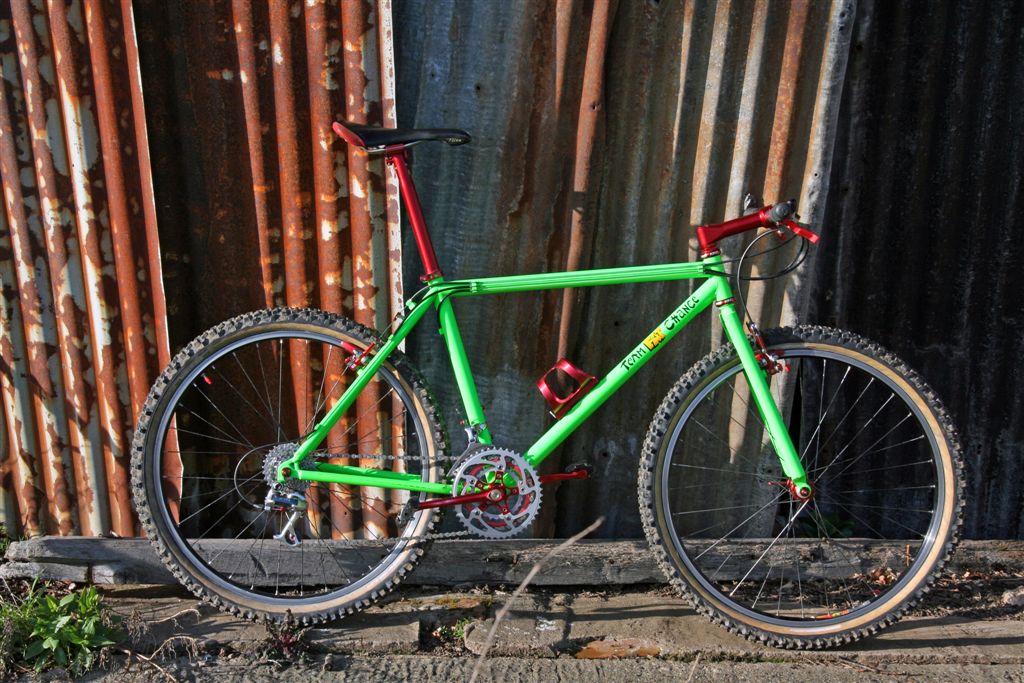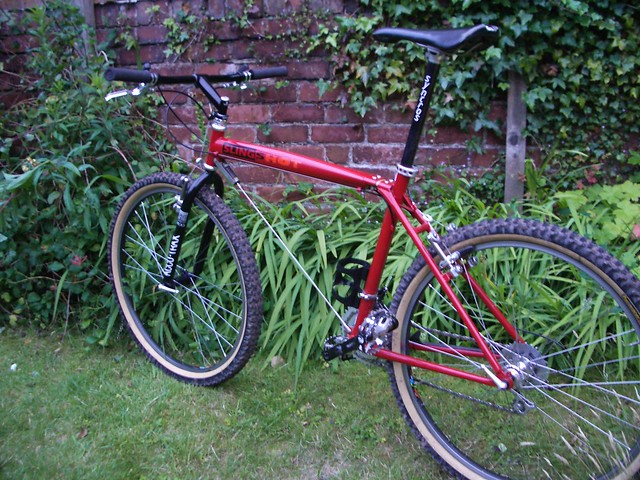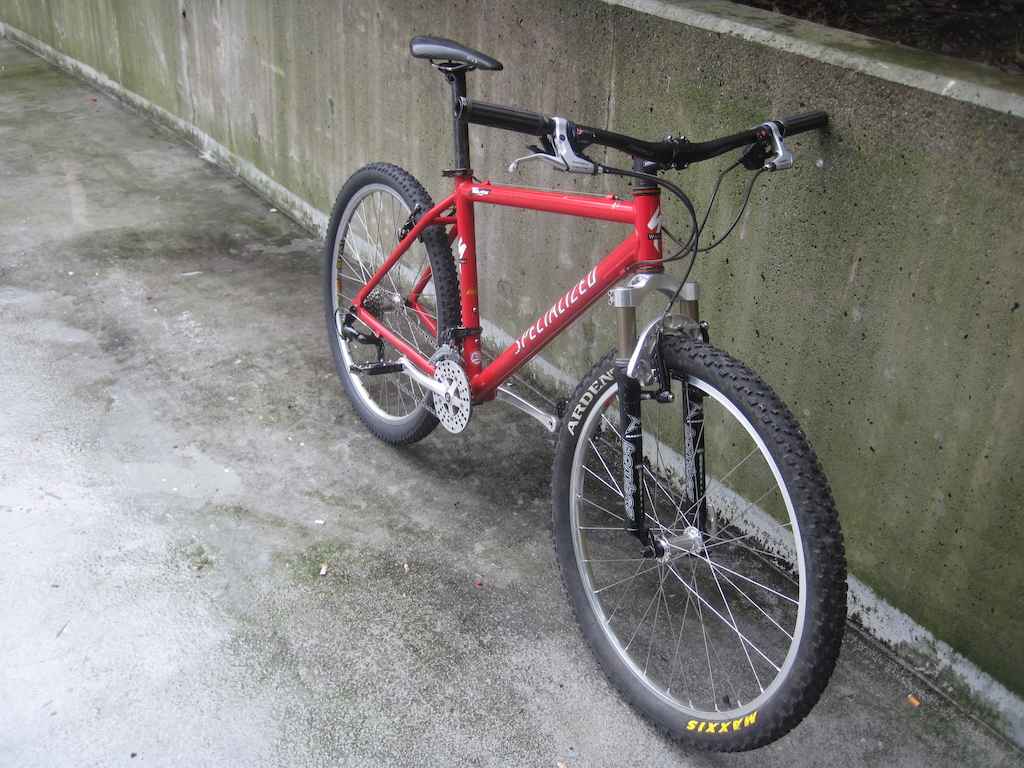Home › Forums › Bike Forum › Did early 90's MTBS have lower front ends?
- This topic has 26 replies, 23 voices, and was last updated 8 years ago by walleater.
-
Did early 90's MTBS have lower front ends?
-
deejayenFree MemberPosted 8 years ago
I’ve measured my old MTB. I think it’s a 19″ frame with about 22.5″ top tube, and it has a 130mm stem with flat bars.
Perhaps the frame is smaller than 19″ – it’s a Saracen, and I’m not sure if it’s measured to the top or centre of the actual top tube, or to the top of the seat tube (which extends above the top tube by an inch or two).
I put the cranks in line with the seat tube and measured from the top of the lowest pedal to the top of the saddle, and got around 930mm. I wasn’t able to sit on the bike, but I think the saddle might need to be raised a bit for my ideal saddle height.
The bars are quite low in relation to the saddle, and I remember it putting pressure on my hands, and also of feeling nervous on descents.
If I wanted higher bars, other than fitting a stem with more rise, would I need to look for a larger frame? I quite fancy a bike of similar vintage, but perhaps they’ll all have the same riding position.
Do modern bikes have taller head tubes?
dragonFree MemberPosted 8 years agoYes by a lot IME, bar height would have been a good 2-3″ lower than the saddle.
 philjuniorFree MemberPosted 8 years ago
philjuniorFree MemberPosted 8 years agoThat Saracen comparison might even be a bit misleading in terms of the scale of the difference – I remember the “entry level” bikes used to have shorter/higher front end/slacker angled geometry even at the end of the 90s.
deejayenFree MemberPosted 8 years agoThanks. This is an old photo of the bike in question:

It currently has off-road tyres, and the thing on the handlebars is no longer there, but it shows the saddle height and bar height.
munrobikerFree MemberPosted 8 years agoMy dad’s 1997 GT’s bars come up to only just above the top of my 160mm Rockshox Pikes.
davidtaylforthFree MemberPosted 8 years agoIf you’re using SPDs, you could always try a mid foot cleat position. Yuo’ll have to lwoer your saddle quite a bit to accommodate this.
cynic-alFree MemberPosted 8 years agophiljunior – Member
That Saracen comparison might even be a bit misleading in terms of the scale of the difference
…moreso becsause the modern one is about 2 sizes smaller…
OP – yes – mostly due to suss forks being way longer, and riser bars.
deejayenFree MemberPosted 8 years agoI hadn’t really thought of that. I use a mid-foot cleat position on my recumbents, but not on my SPD shoes. The bike currently has flat pedals (last time I rode it I was wearing Five Ten shoes).
deejayenFree MemberPosted 8 years agoI’ve just had a look through some old Saracen catalogues on Retrobike, and although I haven’t remembered what year mine is from, it looks like Saracens were measured from the centre of the bottom bracket to the centre of the top tube. I’ll have to re-measure, but I think that might mean my frame is a 17″. I remember when I bought it that ‘standover’ clearance was a big thing, and I think I remember the guy in the shop persuading me to go for the smaller bike. However, it’s a long time ago! If it does prove to be a 17″ it’s likely that the bike is too small for me anyhow.
otsdrFree MemberPosted 8 years agoProbably the old bike is just too small, on a new bike the amount of exposed seatpost would be ridiculuous.
Rubber_BuccaneerFull MemberPosted 8 years agoYes. Smaller wheels + shorter forks + flat bars = lower front ends
Just add 22″ bars for twitchiness that was sold as fast handling back in the day.
Stevet1Full MemberPosted 8 years agoThat’s not a big saddle > bars drop.
This is how a 90’s bike should look… (Not mine, gorgeous build though)

Having said that I like my retrobikes as riders as well, my slingshot has quite a high rise tioga stem and 25″ wide upswept fat chance bars so it rides perfectly acceptably for what it can handle.
 lungeFull MemberPosted 8 years ago
lungeFull MemberPosted 8 years agoI’m looking at these pics thinking that my current bikes look very similar to this. Not sure I’ve owned a bike with the saddle below or even level with the bars since I was 10 years old!
chiefgrooveguruFull MemberPosted 8 years agoMTB geometry really lost its way around 1990 – it all got too roadie. The Peugeot I had as a child in the ’80s looked more like a Klunker, with a short high rise stem and seriously wide bars (proportionally similar to 800s on full-grown me). Angles looked slacker too. And then I got a Muddy Fox – narrow bars, steep, taller shorter frame proportions. Progress…
lungeFull MemberPosted 8 years agoAnd then I got a Muddy Fox – narrow bars, steep, taller shorter frame proportions. Progress..
True, but MTB in the 90’s mainly involved riding round grassy fields, fireroads and the occasional bit of singletrack, not unlike CX in fact. It was focused around XC racing and even the odd bit of DH was down a fireroad. For that kind of riding, road biased geometry was the right tool for the job.
bj116Free MemberPosted 8 years agoLoving that Fat Chance!
Check out any 90s Mint Sauce cartoon for a characature of that head down, asre up, dangly leg look.
My mate used to look like a frog sat on a fence post. 😀markrhFree MemberPosted 8 years agoJust looking at those handlebar positions and I can feel myself flying through the air high above the the bars wondering how much the impact with the ground is going hurt… 😆
YakFull MemberPosted 8 years agoYes! Had a mongoose iboc comp back then. Very low front, especially as I paired it up with some p2 forks. Awesome bike, v light and climbed brilliantly.
maccruiskeenFull MemberPosted 8 years agoIf I wanted higher bars, other than fitting a stem with more rise, would I need to look for a larger frame?
Different frame sizes don’t necessarily make all that much difference to the bar height – there would be some difference but not much – the characteristic of a bike is defined by the relationship between the three main contact points (bars, saddle and pedals) and the two bits on the ground (the wheels). So across a range of sizes for one model of bike the maker is trying to make adjustments for rider fit but retain those characteristics. So the bar height might vary across sizes to accommodate fit, but it’ll vary as little as possible, because across the range the wheel size and the fork height are a constant.
If you want a bike thats higher at the front buy one thats designed to be high at the front rather than a larger version of a bike that isn’t.
wzzzzFree MemberPosted 8 years agoJust stick some high riser bars on.
http://www.gussetbikes.com/products-mtb-information.php?id=HBGUWH5WchestercopperpotFree MemberPosted 8 years agoI believe the expression is arse up head down, don’t google it though!
Was a combination of XC dominance and roadie throwbacks/repurposing/making do.
walleaterFull MemberPosted 8 years agoThat Fat Chance sums up everything that was wrong with mountain bikes back then (and I was there….). ‘NORBA’ geometry wrecked MTBs for a long while. You can rescue the older bikes up to a point with a shorter stem / riser / longer fork though, like in my ’emergency mountain bike’ that I built up when my main ride was being resprayed:

The topic ‘Did early 90's MTBS have lower front ends?’ is closed to new replies.




